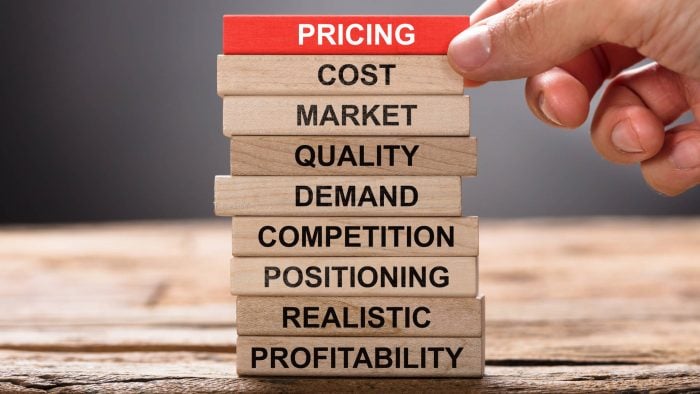
In my March column for CustomerThink, titled “Pricing to Win in B2B: The Mindset to Achieve More Revenue and Profit,” I discussed the mindset attributes needed to achieve solid pricing results: courage, differentiation, and relationships. Assuming you are now equipped with this ninja pricing mindset, it’s time to explore specifics of how to choose and implement the pricing model that generates greater profitability while preserving long-term relationships.
I’ve written a fair amount about how B2B companies spend too little time on branding and why this impacts results, and the same is true for pricing strategy. It’s a tough subject to deal with so companies often accept the status quo or follow the lead of their competitors. Even if you have an excellent product, you can fail to gain traction due to a poor pricing model – often based on hunches or overinflated opinions of value and expected market acceptance.
To set the table for pricing success, you need to start with clearly identified objectives, both quantitative and qualitative. Don’t shortchange this process or try to achieve every conceivable objective at once since certain objectives are mutually exclusive. Here are some examples.
Maximize revenue. This means that you will do what is necessary to achieve better results at the top-line but are not as concerned with the bottom-line (P&L).
Maximize profits. Here, you are not so concerned with revenue, but rather with your bottom-line P&L number. Note that the optimum pricing for profits is often not the same as that for revenue.
Protect margins. In this case, you are looking for strong margins on individual sales and may use a cost-plus approach to ensure adequate margins.
Grab market share. This is an approach favored by many cloud-based/SaaS software vendors where they are willing to lose money on every initial transaction to attract a large number of customers. In this strategy, the lifetime value (LTV) of a customer is the golden metric, not the impact of a single transaction. Note that some people refer to this as a “loss leader” strategy.
Penetrate new markets. If you are entering a market with entrenched competitors, you will either have to show significant and valuable differentiation, or you will have to price competitively.
Attract strategic partners. There are two ways to use pricing as a partner-attraction strategy. First, by pricing in such a way that channel partners make decent margins on your products and/or services, and second, because they acknowledge your pricing strategy as a competitive advantage.
Discourage unwanted customers. Companies pursue this objective when they are in a position to turn away business and prefer to choose their own clients. This works particularly well for service companies that do not have a published rate card. My company, Fusion Marketing Partners, has used the discouragement pricing strategy to discourage potential clients where we feel the fit may not be right. Instead of turning away the business and insulting the prospect, we let them say no to us.

Understanding the Pricing Terrain
I use the term ‘pricing terrain’ because, just like on a battlefield, there are many variables to consider when deciding your pricing approach. First, you need to know your own company, and its strengths and weaknesses. You must also understand relevant competitors and why someone would buy from them and not you. A thorough understanding of the industry you are selling into is important, as well as the environment, habits, and motivations of your target audience. How are they buying now and how would they prefer to buy?
As I discussed in the March column, differentiation is a key (often “the key”) to pricing success, both as a mindset and in how you implement your strategy. But to make the differentiation strategy work, you will need to identify one or more “true” competitive differentiators. And by this, I don’t mean something like: “we provide superior service” or “we really love our customers.” These are platitudes, not differentiators, at least until your customers agree with your boasts. The differentiator must be acknowledged as valuable by your target audience, meaning a willingness to pay premium pricing.
Of many pricing pitfalls, selling a differentiated product at a commodity price point is perhaps the worst. For example, my company just hired a marketing specialist with considerable experience in a highly technical industry. We are paying this individual 20 percent more than the going rate for consultants that lack this individual’s domain expertise, but only because he was smart enough to monetize his differentiation.
B2B buyers have one thing in common with B2C buyers – time is usually their most precious commodity – more so than the budget dollars they control. You can often command a premium price If you demonstrate how your product or service gives them more time and/or makes life easier
Rolling Out Your New Pricing Model
Beware of the law of unintended consequences when changing your pricing model. If possible, prototype the pricing with a small segment before rolling it out to the customer and prospect community – to avoid losing customers or creating dissension in your customer base (yes, they really do talk to each other!). Two methods we use to test pricing are the A/B test — offering the new vs. existing pricing — and having your enterprise reps test the unpublished pricing with select prospects. Remain in stealth mode and don’t publish the new pricing until the model has passed the test.
Speaking of unintended consequences, I have seen B2B companies incentivize unprofitable sales by paying commissions on total revenue, not profitable revenue. Reps understand the game and jump into early discounting to drive faster and easier sales. The remedy for this is to create a simple and clear comp plan that pays out higher on profitable sales.
If possible, pair communications about higher prices with the delivery of additional value. The point is to reduce any potential sting from the price increase. For example, if you are going to charge 10 percent more, make sure you announce additional functionality or product upgrades that have a perceived value that justifies that price increase. Note that I use the word “perceived” because value is subjective. As Warren Buffet put it, “Price is what you pay. Value is what you receive”.



